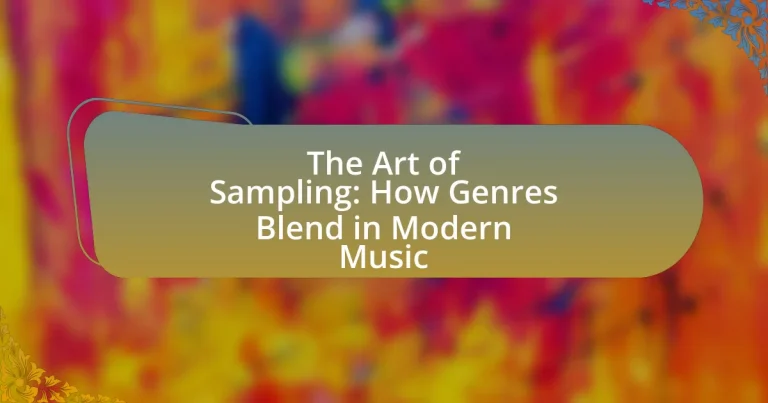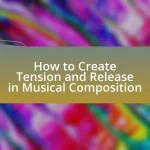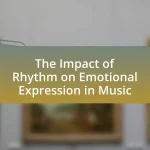The article explores the art of sampling in modern music, a technique that involves reusing portions of sound recordings to create new compositions. It traces the evolution of sampling from its roots in hip-hop and electronic music during the 1980s and 1990s to its current role in genre blending and cultural exchange. Key topics include the technological advancements that have shaped sampling methods, the legal considerations surrounding copyright, and the impact of sampling on the creation of new musical styles. The article also highlights notable examples of genre fusion and provides best practices for artists to navigate the complexities of sampling while ensuring originality and compliance with legal standards.
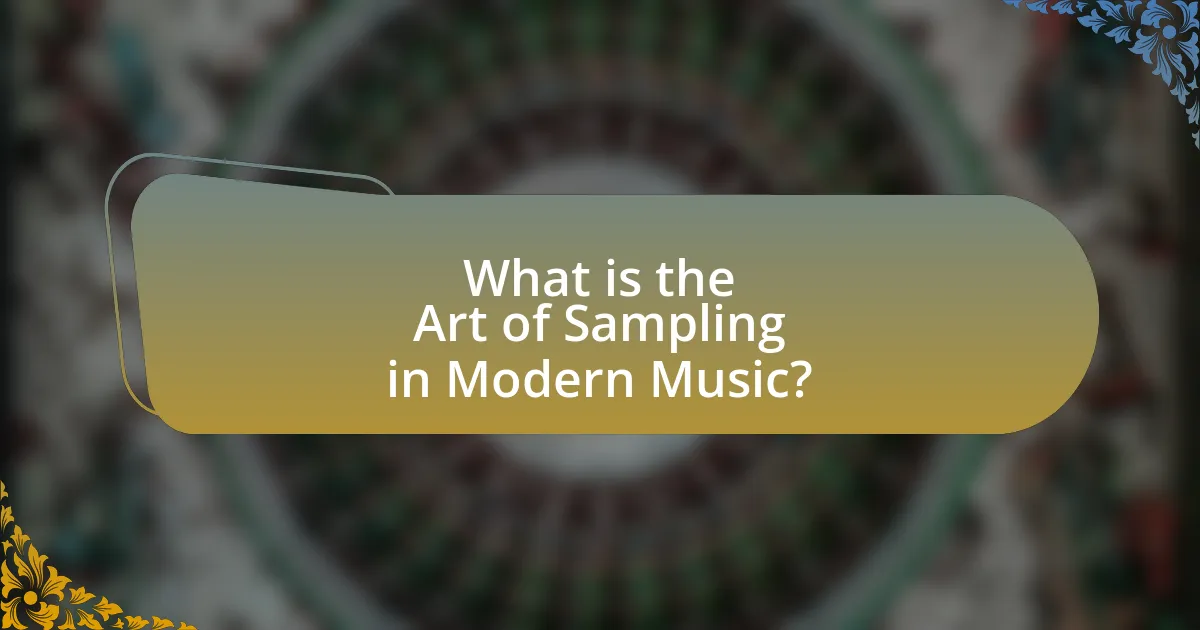
What is the Art of Sampling in Modern Music?
The art of sampling in modern music involves the technique of taking a portion of a sound recording and reusing it in a different song or piece of music. This practice allows artists to blend genres, create new sounds, and pay homage to previous works. Sampling has roots in hip-hop and electronic music, where it became prominent in the 1980s and 1990s, with artists like Grandmaster Flash and The Beastie Boys pioneering its use. The legality of sampling has led to the establishment of copyright laws, requiring artists to obtain permission or licenses for the original recordings they sample. This practice not only influences the creative process but also shapes the evolution of musical genres, as seen in the fusion of hip-hop, pop, and electronic music.
How has sampling evolved over the years?
Sampling has evolved significantly over the years, transitioning from simple, analog techniques to complex digital processes. In the 1970s, early hip-hop artists utilized vinyl records to create loops and beats, often using rudimentary equipment like turntables and mixers. The introduction of digital samplers in the 1980s, such as the Akai MPC series, allowed musicians to manipulate sounds more precisely, enabling the incorporation of diverse genres and styles. By the 1990s and 2000s, software-based sampling tools like Pro Tools and Ableton Live emerged, providing unprecedented flexibility and access to vast libraries of sounds. This evolution has led to a blending of genres, as artists can now easily sample and remix tracks from various musical backgrounds, reflecting a more globalized music culture. The rise of the internet and platforms like SoundCloud has further democratized sampling, allowing independent artists to share and collaborate on a global scale.
What historical events influenced the rise of sampling?
The rise of sampling in music was significantly influenced by the advent of hip-hop culture in the late 1970s and early 1980s. This cultural movement, characterized by DJs using turntables to mix and loop existing records, laid the groundwork for sampling as a creative technique. The introduction of affordable digital samplers in the 1980s, such as the Akai MPC series, further propelled this trend by allowing artists to easily manipulate and incorporate snippets of sound from various sources into their compositions. Additionally, landmark legal cases, such as the 1991 “Campbell v. Acuff-Rose Music, Inc.” decision, established precedents for fair use in sampling, legitimizing its use in music production and encouraging artists to experiment with this innovative form of expression.
How did technology impact the development of sampling techniques?
Technology significantly advanced the development of sampling techniques by enabling more precise and versatile audio manipulation. Innovations such as digital audio workstations (DAWs), MIDI technology, and high-quality audio converters allowed musicians and producers to easily record, edit, and integrate samples from various sources. For instance, the introduction of the Akai MPC series in the 1980s revolutionized sampling by providing intuitive interfaces for triggering samples and sequencing music, which became foundational in hip-hop and electronic music. Additionally, software advancements like Ableton Live and Logic Pro have further democratized access to sampling tools, allowing a broader range of artists to experiment with genre blending and creative sound design.
Why is sampling significant in genre blending?
Sampling is significant in genre blending because it allows artists to incorporate elements from diverse musical styles, creating innovative and hybrid sounds. This technique enables musicians to pay homage to their influences while also pushing the boundaries of traditional genres. For instance, the use of a hip-hop beat combined with jazz instrumentation can result in a unique fusion that attracts listeners from both genres. Historical examples include the rise of hip-hop in the 1980s, where artists like Grandmaster Flash utilized samples from rock and funk tracks, leading to the emergence of new subgenres and expanding the musical landscape.
What role does sampling play in creating new musical styles?
Sampling plays a crucial role in creating new musical styles by allowing artists to incorporate existing sounds and elements into their work, thereby fostering innovation and genre blending. This technique enables musicians to draw from a diverse range of influences, as seen in genres like hip-hop, where sampling has been foundational since the 1970s, allowing for the integration of funk, soul, and jazz elements. The use of samples can transform the original context of a sound, creating fresh interpretations and new emotional resonances, which has led to the emergence of sub-genres such as trap and lo-fi hip-hop. Notably, the 1989 track “Fight the Power” by Public Enemy exemplifies how sampling can serve as a political statement while simultaneously creating a new soundscape, illustrating the transformative power of this technique in shaping contemporary music.
How does sampling contribute to cultural exchange in music?
Sampling contributes to cultural exchange in music by allowing artists to incorporate elements from diverse musical traditions into their work, thereby creating a fusion of styles. This practice not only introduces listeners to new genres and cultural sounds but also fosters collaboration among artists from different backgrounds. For instance, hip-hop artists often sample jazz, funk, and soul tracks, which not only revitalizes these older genres but also exposes a broader audience to their cultural significance. The use of sampling has been documented in studies, such as the research by David Hesmondhalgh in “The Cultural Industries,” which highlights how sampling serves as a bridge between cultures, promoting understanding and appreciation through shared musical experiences.
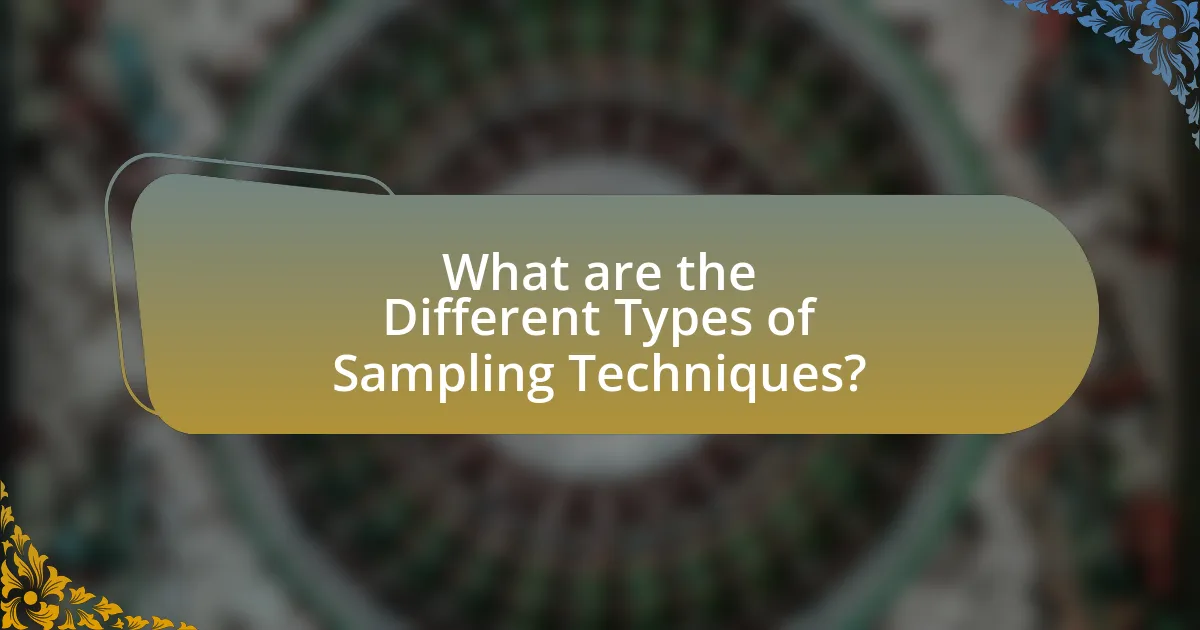
What are the Different Types of Sampling Techniques?
The different types of sampling techniques include simple random sampling, stratified sampling, systematic sampling, cluster sampling, and convenience sampling. Simple random sampling involves selecting individuals randomly from a population, ensuring each member has an equal chance of being chosen. Stratified sampling divides the population into subgroups and samples from each subgroup to ensure representation. Systematic sampling selects every nth individual from a list, providing a structured approach. Cluster sampling involves dividing the population into clusters and randomly selecting entire clusters for study. Convenience sampling selects individuals based on ease of access, which may introduce bias. Each technique serves specific research needs and influences the validity of results.
How do different sampling methods affect music production?
Different sampling methods significantly influence music production by altering the texture, rhythm, and overall sound of a track. For instance, using loop-based sampling allows producers to create repetitive motifs that can drive a song’s structure, while one-shot sampling provides distinct sounds that can be layered for complexity. Additionally, techniques like time-stretching and pitch-shifting can transform samples, enabling producers to fit them seamlessly into various genres. Historical examples include hip-hop artists in the 1980s who utilized sampling to blend funk and soul elements, creating new musical landscapes. This adaptability of sampling methods demonstrates their critical role in shaping contemporary music production.
What is the difference between loop-based and one-shot sampling?
Loop-based sampling involves creating a continuous audio loop that can be repeated throughout a track, allowing for a consistent rhythmic and melodic foundation. In contrast, one-shot sampling refers to the use of individual audio samples that are triggered once, often to create specific sounds or effects without repetition. This distinction is crucial in music production, as loop-based sampling provides a stable backdrop for compositions, while one-shot sampling adds variety and dynamic elements to the sound.
How do producers choose samples for their tracks?
Producers choose samples for their tracks by considering the emotional impact, genre compatibility, and originality of the sound. They often select samples that evoke specific feelings or memories, aligning with the overall mood of the track. Additionally, producers analyze the genre of the sample to ensure it complements the style of their music, as certain genres have characteristic sounds that resonate well together. Originality is also crucial; producers aim to find unique samples that stand out and contribute to their artistic identity. This approach is supported by the fact that successful tracks often incorporate samples that enhance their distinctiveness while maintaining a cohesive sound.
What are the legal considerations in sampling?
Legal considerations in sampling primarily involve copyright law, which protects original works from unauthorized use. When sampling music, artists must obtain permission from the original copyright holders, typically the songwriters and record labels, to avoid infringement. Failure to do so can result in legal disputes, financial penalties, and the removal of the sampled work from distribution. Additionally, the Fair Use doctrine may apply in some cases, allowing limited use of copyrighted material without permission, but this is often subject to interpretation and can vary by jurisdiction. Courts consider factors such as the purpose of the use, the nature of the original work, the amount used, and the effect on the market value of the original work when determining Fair Use applicability.
What are the copyright implications of using samples?
Using samples in music can lead to copyright infringement if the original work is not licensed properly. Copyright law protects the original creator’s rights, meaning that using a sample without permission can result in legal consequences, including lawsuits and financial penalties. For instance, a notable case is the 1991 lawsuit against Biz Markie, where the court ruled that unauthorized sampling constituted copyright infringement, reinforcing the necessity of obtaining licenses for any sampled material. Therefore, musicians must navigate copyright laws carefully to avoid legal issues when incorporating samples into their work.
How can artists navigate the legal landscape of sampling?
Artists can navigate the legal landscape of sampling by obtaining proper licenses for the original works they wish to sample. This involves identifying the copyright holders of the sampled material and negotiating a licensing agreement, which may include a fee or royalties. According to the U.S. Copyright Office, sampling without permission can lead to legal disputes and potential financial penalties, as copyright law protects the rights of original creators. Additionally, artists can explore using samples that are in the public domain or those available under Creative Commons licenses, which often have fewer restrictions. By understanding these legal requirements and options, artists can effectively incorporate sampling into their work while minimizing legal risks.
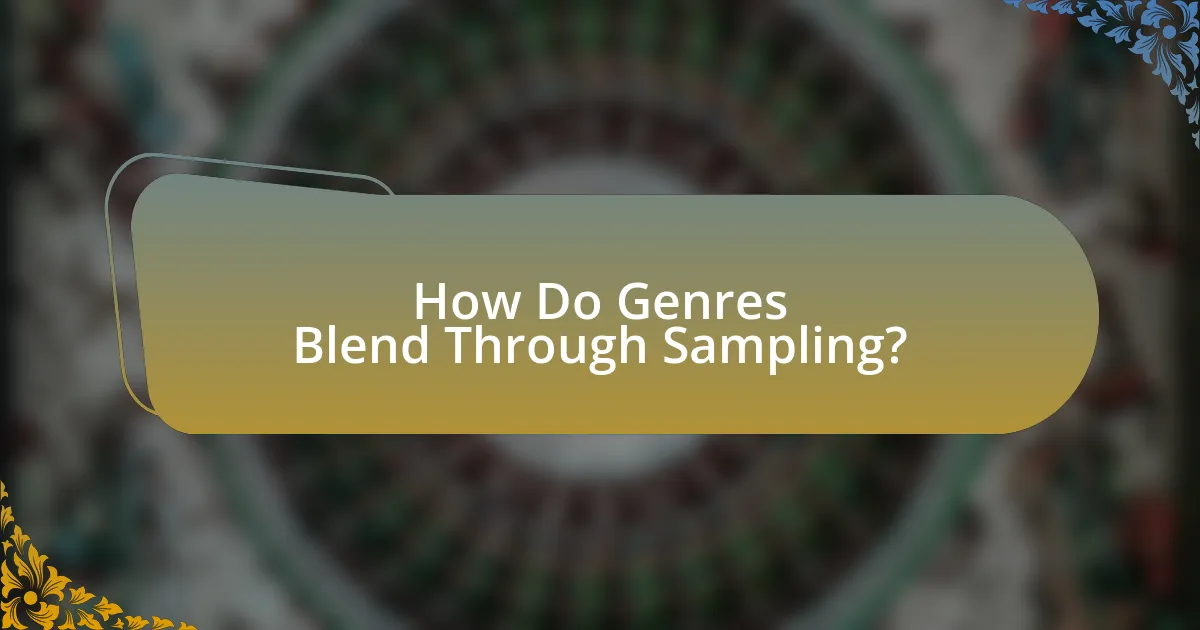
How Do Genres Blend Through Sampling?
Genres blend through sampling by incorporating elements from one musical genre into another, creating a fusion that enhances creativity and diversity in music. This process allows artists to borrow melodies, rhythms, or sounds from existing tracks, effectively merging different styles and influences. For example, hip-hop frequently samples funk and soul records, which not only preserves the essence of the original music but also introduces it to new audiences. The practice of sampling has been documented in various studies, such as the research by Kahn and Dyer in “Sampling and the Art of Music Production,” which highlights how sampling facilitates genre innovation and cross-pollination in contemporary music.
What are some notable examples of genre blending through sampling?
Notable examples of genre blending through sampling include “Walk This Way” by Run-D.M.C. featuring Aerosmith, which fused hip-hop and rock, and “Paper Planes” by M.I.A., which combined elements of hip-hop, reggae, and world music. “Walk This Way” revitalized Aerosmith’s career and brought hip-hop to mainstream audiences, while “Paper Planes” incorporated a sample from The Clash’s “Straight to Hell,” showcasing a blend of genres that achieved significant commercial success and critical acclaim. These tracks exemplify how sampling can create innovative cross-genre collaborations that resonate widely.
How has hip-hop influenced other genres through sampling?
Hip-hop has significantly influenced other genres through sampling by introducing diverse musical elements and creating new sounds. This practice allows artists to incorporate snippets of existing songs, which can blend genres like rock, jazz, and electronic music with hip-hop. For example, the use of funk and soul samples in hip-hop tracks has led to a resurgence of interest in these genres, as seen in tracks like “Uptown Funk” by Mark Ronson featuring Bruno Mars, which heavily samples funk influences. Additionally, hip-hop’s sampling techniques have inspired electronic music producers to experiment with similar methods, leading to the rise of genres like trap and future bass. The impact of hip-hop sampling is evident in the Billboard charts, where collaborations across genres have become increasingly common, showcasing the genre’s ability to transcend traditional musical boundaries.
What impact has electronic music had on traditional genres via sampling?
Electronic music has significantly influenced traditional genres through sampling by introducing new textures and sounds that reshape their identity. This impact is evident in genres like hip-hop, where artists such as DJ Shadow and J Dilla have utilized samples from jazz, funk, and soul to create innovative tracks that blend old and new elements. The practice of sampling allows for the preservation and reinterpretation of traditional music, as seen in the widespread use of classic rock and pop samples in electronic dance music, which has led to a resurgence of interest in these original works. Furthermore, the legal and cultural discussions surrounding sampling have prompted traditional artists to collaborate with electronic musicians, fostering a cross-pollination of styles that enriches both genres.
How can artists effectively blend genres using samples?
Artists can effectively blend genres using samples by carefully selecting and manipulating elements from different musical styles to create a cohesive sound. This process involves choosing samples that complement each other, such as combining a jazz piano riff with a hip-hop beat, which can enhance the emotional depth and rhythmic complexity of the track. Additionally, artists can utilize techniques like pitch shifting, time stretching, and layering to seamlessly integrate samples into their compositions, ensuring that the final product feels unified rather than disjointed. Historical examples include the genre-blending works of artists like DJ Shadow, whose album “Endtroducing…..” is noted for its innovative use of samples from various genres, demonstrating how diverse influences can coexist harmoniously in a single piece of music.
What techniques can be used to create a seamless blend of genres?
Techniques to create a seamless blend of genres include cross-genre instrumentation, hybrid rhythms, and thematic integration. Cross-genre instrumentation involves using instruments typical of one genre within another, such as incorporating a violin in a hip-hop track, which can create a unique sound palette. Hybrid rhythms combine elements from different genres, like fusing the syncopation of jazz with the beats of electronic dance music, resulting in a fresh rhythmic structure. Thematic integration refers to the blending of lyrical themes or storytelling techniques from various genres, allowing for a cohesive narrative that resonates across different musical styles. These techniques have been effectively utilized by artists like Billie Eilish and Lil Nas X, who draw from multiple genres to create their distinctive sounds.
How can understanding genre characteristics enhance sampling choices?
Understanding genre characteristics enhances sampling choices by allowing producers to select elements that align with the stylistic and emotional nuances of a specific genre. For instance, recognizing that hip-hop often incorporates rhythmic breaks and vocal samples can guide a producer to choose samples that resonate with the genre’s foundational elements. This targeted approach not only ensures authenticity but also increases the likelihood of creating a cohesive sound that appeals to the intended audience. Studies have shown that successful samples often reflect the defining traits of the genre they are drawn from, reinforcing the importance of genre knowledge in the sampling process.
What are best practices for sampling in modern music?
Best practices for sampling in modern music include obtaining proper clearance for samples, ensuring creative originality, and maintaining a clear artistic vision. Proper clearance is essential to avoid legal issues, as unauthorized use can lead to copyright infringement lawsuits. Creative originality involves manipulating samples to create unique sounds, which can enhance the artist’s identity and differentiate their work. Maintaining a clear artistic vision ensures that the sampled material aligns with the overall theme and message of the music, fostering a cohesive listening experience. These practices are supported by industry standards and legal frameworks that emphasize the importance of respecting intellectual property rights while encouraging innovation in music production.
How can artists ensure originality while using samples?
Artists can ensure originality while using samples by creatively manipulating the sampled material and incorporating unique elements into their compositions. This can involve altering the pitch, tempo, or structure of the sample, as well as layering it with original instrumentation or vocals. For instance, the use of techniques such as chopping, looping, and re-contextualizing samples can transform the original sound into something distinctly new. Additionally, artists can blend samples from various genres, creating a fusion that reflects their individual style. This approach not only enhances originality but also aligns with the legal framework of sampling, which often requires significant transformation to avoid copyright infringement.
What tools and software are recommended for effective sampling?
For effective sampling, recommended tools and software include Ableton Live, FL Studio, and Logic Pro X. These digital audio workstations (DAWs) provide robust features for manipulating samples, including time-stretching, pitch-shifting, and layering. Ableton Live is particularly favored for its intuitive interface and real-time performance capabilities, making it ideal for live sampling. FL Studio offers a user-friendly environment with powerful sampling plugins, while Logic Pro X includes advanced features like Flex Time and Flex Pitch for precise sample editing. These tools are widely used in the music industry, as evidenced by their adoption by professional producers and artists for creating genre-blending tracks.
